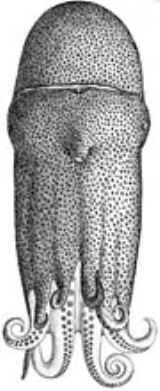
Seven-arm Octopus
Encyclopedia
The Seven-arm Octopus is the largest known species of octopus
based on scientific records, with a total estimated length of 4 m and weight of 75 kg. However, there have been claims of even larger octopuses of the species Enteroctopus dofleini.
(a specially modified arm used in egg fertilization) is coiled in a sac beneath the right eye. Due to this species' thick gelatinous tissue, the arm is easily overlooked, giving the appearance of just seven arms. However, like other octopuses, it actually has eight.
In 2002, a single specimen of giant proportions was caught by fisheries trawling off the eastern Chatham Rise
, New Zealand
. This specimen, the largest of this species and of all octopuses, was the first validated record of Haliphron from the South Pacific
. It had a mantle
length of 0.69 m, total length of 2.90 m, and weight of 61.0 kg, although it was incomplete.
The type specimen of H. atlanticus was collected in the Atlantic Ocean
at 38°N 34°W. It is deposited at the Zoologisk Museum, University of Copenhagen
.
The genera
Alloposina Grimpe, 1922, Alloposus Verrill, 1880 and Heptapus Joubin, 1929 are junior synonyms of Haliphron.
Octopus
The octopus is a cephalopod mollusc of the order Octopoda. Octopuses have two eyes and four pairs of arms, and like other cephalopods they are bilaterally symmetric. An octopus has a hard beak, with its mouth at the center point of the arms...
based on scientific records, with a total estimated length of 4 m and weight of 75 kg. However, there have been claims of even larger octopuses of the species Enteroctopus dofleini.
Description
The Seven-arm Octopus is so named because in males the hectocotylusHectocotylus
A hectocotylus is one of the arms of the male of most kinds of cephalopods that is modified in various ways to effect the fertilization of the female's eggs. It is a specialized, extended muscular hydrostat used to store spermatophores, the male gametophore...
(a specially modified arm used in egg fertilization) is coiled in a sac beneath the right eye. Due to this species' thick gelatinous tissue, the arm is easily overlooked, giving the appearance of just seven arms. However, like other octopuses, it actually has eight.
In 2002, a single specimen of giant proportions was caught by fisheries trawling off the eastern Chatham Rise
Chatham Rise
The Chatham Rise is an area of ocean floor to the east of New Zealand, forming part of the Zealandia continent. It stretches for some from near the South Island in the west, to the Chatham Islands in the east...
, New Zealand
New Zealand
New Zealand is an island country in the south-western Pacific Ocean comprising two main landmasses and numerous smaller islands. The country is situated some east of Australia across the Tasman Sea, and roughly south of the Pacific island nations of New Caledonia, Fiji, and Tonga...
. This specimen, the largest of this species and of all octopuses, was the first validated record of Haliphron from the South Pacific
Oceania
Oceania is a region centered on the islands of the tropical Pacific Ocean. Conceptions of what constitutes Oceania range from the coral atolls and volcanic islands of the South Pacific to the entire insular region between Asia and the Americas, including Australasia and the Malay Archipelago...
. It had a mantle
Mantle (mollusc)
The mantle is a significant part of the anatomy of molluscs: it is the dorsal body wall which covers the visceral mass and usually protrudes in the form of flaps well beyond the visceral mass itself.In many, but by no means all, species of molluscs, the epidermis of the mantle secretes...
length of 0.69 m, total length of 2.90 m, and weight of 61.0 kg, although it was incomplete.
The type specimen of H. atlanticus was collected in the Atlantic Ocean
Atlantic Ocean
The Atlantic Ocean is the second-largest of the world's oceanic divisions. With a total area of about , it covers approximately 20% of the Earth's surface and about 26% of its water surface area...
at 38°N 34°W. It is deposited at the Zoologisk Museum, University of Copenhagen
University of Copenhagen
The University of Copenhagen is the oldest and largest university and research institution in Denmark. Founded in 1479, it has more than 37,000 students, the majority of whom are female , and more than 7,000 employees. The university has several campuses located in and around Copenhagen, with the...
.
The genera
Genus
In biology, a genus is a low-level taxonomic rank used in the biological classification of living and fossil organisms, which is an example of definition by genus and differentia...
Alloposina Grimpe, 1922, Alloposus Verrill, 1880 and Heptapus Joubin, 1929 are junior synonyms of Haliphron.
Further reading
- Bakken, T. & T. Holthe 2002. Haliphron atlanticum (Cephalopoda, Alloposidae) caught in Skorafjorden (64°N), Norway. Fauna norv. 22: 37-38.
- Willassen, E. 1986. Haliphron atlanticus Steenstrup (Cephalopoda: Octopoda) from the coast of Norway. Sarsia 71: 35-40.

